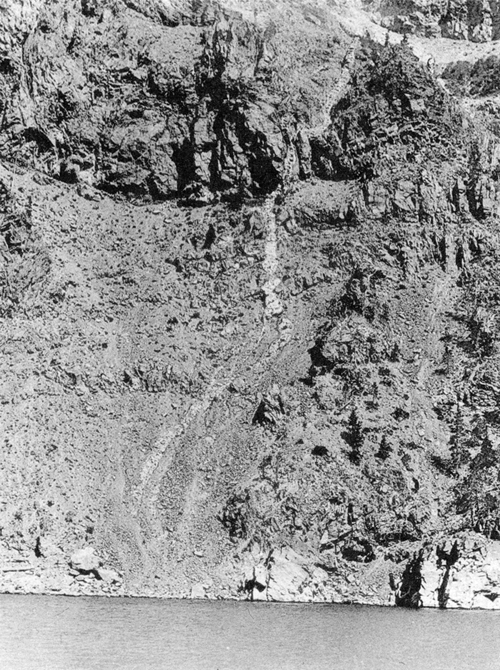The Geology of Crater Lake National Park, Oregon With a reconnaissance of the Cascade Range southward to Mount Shasta by Howell Williams
The Main Andesite Cone of Mount Mazama
Dikes
Dacite Dikes
|
Plate 7, Fig. 2. Dacite dike on the caldera wall beneath Llao Rock. (Photograph by George Grant, National Park Service.) |
Almost immediately beneath the central part of the dacite flow forming Llao Rock, there are two small dikes of dacite. Diller maintained that one or possibly both contributed to the escape of the Llao lava, but of this there is no proof. Neither intrusion can be seen to connect with the floe, and it seems more likely that both dikes and flow were supplied from a common feeder.
Of the two dikes, the more westerly varies between 6 and 7 feet in width. Approximately 60 feet above the level of the lake it disappears. The margins of the intrusion consist of jet-black glass, but the interior is pale gray, holocrystalline, and well banded. Slender prisms of hornblende and stumpy laths of plagioclase are scattered throughout, and minute spheroids of cristobalite line cavities in the pale interior.
The other dike (plate 7, figure 2) follows a sinuous course across the caldera wall and can be traced to within approximately 150 feet of the base of the Llao flow. For most of its course this dike measures between 4 and 5 feet in width, but at the top it diminishes to a width of 3 feet 6 inches. The margins consist of black obsidian. Within, the dacite first becomes holocrystalline, pale gray, and almost pumiceous, and then, in the center, becomes darker, less vesicular, and strongly banded. In the same direction, the content of cristobalite increases. Similar variations way be noted in the Llao flow.
***previous*** — ***next***


